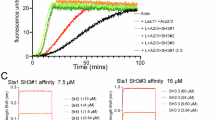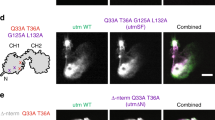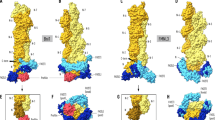Abstract
Using the two-hybrid protein interaction reporter system, actin, profilin, Srv2p and two SH3-containing proteins are found to bind yeast actin in vivo. When tested for ability to interact with 35 actin mutations distributed over the monomer surface, distinct subsets of mutations characteristic for each putative ligand are found to disrupt binding. In particular, the pattern of differential interactions for the actin-act in interaction is consistent with published structures for the actin filament. Despite functional similarities, the patterns of differential interaction for Srv2p and profilin are different. In contrast, the patterns for profilin and the SH3 domain proteins suggest a shared binding site and commonality in mechanism.
This is a preview of subscription content, access via your institution
Access options
Subscribe to this journal
Receive 12 print issues and online access
$259.00 per year
only $21.58 per issue
Buy this article
- Purchase on SpringerLink
- Instant access to full article PDF
Prices may be subject to local taxes which are calculated during checkout
Similar content being viewed by others
References
Chien, C., Bartel, P.L., Sternglanz, R. and Fields, S. The two hybrid system: A method to identify and clone genes for proteins that interact with a protein of interest. Proc. natn. Acad. Sci. U.S.A. 88, 9578–9582 (1991).
Wertman, K.F., Drubin, D.G. & Botstein, D. Systematic mutational analysis of the yeast ACT1 gene. Genetics 132, 337–350 (1992).
Durfee, T. et al. The retinoblastoma protein associates with the protein phosphatase type 1 catalytic subunit. Genes Develop. 7, 555–569 (1993).
Gallwitz, D. & Sures, I. Structure of a split gene: Complete nucleotide sequence of the actin gene in Saccharomyces cerevisiae. Proc. natn. Acad. Sci. U.S.A. 77, 2546–2550 (1980).
Ng, R. & Abelson, J. Isolation of the gene for actin in Saccharomyces cerevisiae. Proc. natn. Acad. Sci. U.S.A. 77, 3912–3916 (1980).
Magdolen, V., Oechsner, U., Muller, G. & Bandlow, W. The intron-containing gene for yeast profilin (PFY) encodes a vital function. Molec. cell. Biol. 8, 5108–5115 (1988).
Field, J. et al. Cloning and characterization of CAP, the S. cerevisia gene encoding the 70 kd adenyl cyclase-associated protein. Cell 61, 319–327 (1990).
Fedor-Chaiken, M., Deschenes, R.J. & Broach, J.R. SRV2, a gene required a RAS activation of adenylate cyclase in yeast. Cell 61, 329–340 (1990).
Bauer, F., Urdaci, M., Aigle, M. & Crouzet, M. Alteration of a yeast SH3 protein leads to conditional viability with defects in cytoskeletal and budding patterns. Molec. cell. Biol. 13, 5070–5084 (1993).
Stott, K., Saito, K., Thiele, D.J. & Massey, V. Old yellow enzyme: The discover of multiple isozymes and a family of related proteins. J. biol. Chem. 268, 6097–6106 (1993).
Albig, W. & Entian, K. Structure of yeast glucokinase, a strongly diverged specific aldo-hexose-phosphorylating isoenzyme. Gene 73,141–152 (1988).
Remacha, M., Saenz-Robles, M.T., Vilella, M.D. & Ballesta, J.P. Independent genes coding for the three acidic proteins of the large ribosomal subunit from Saccharomyces cerevisiae. J. biol. Chem. 263, 9094–9101 (1988).
Bass, S.H., Mulkerrin, M.G., Wells, J.A. A systematic mutational analysis of hormone-binding determinants in the human growth hormone receptor. Proc. natn. Acad. Sci. U.S.A. 88, 4498–4502 (1991).
Pawson, T. & Gish, G.D. SH2 and SH3 domains: from structure to function. Cell 71, 359–362 (1992).
Drubin, D.G., Mulholland, J., Zhu, Z. & Botstein, D. Homology of a yeast actin-binding protein to signal transduction proteins and myosin-l. Nature 343, 288–290 (1990).
Trueheart, J., Boeke, J.D. & Fink, G.R. Two genes required for cell fusion during yeast conjugation: evidence for a pheromone-induced surface protein. Molec. cell. Biol. 7, 2316–2328 (1987).
Chenevert, J., Corrado, K., Bender, A., Pringle, I. & Herskowitz, J. A yeast gene (BEM1) necessary for cell polarization whose product contains two SH3 domains. Nature 356, 77–79 (1992).
Kabsch, W., Mannherz, H.G., Suck, D., Pai, E.F. & Holmes, K.C. Atomic structure of the actin: DNase I complex. Nature 347, 37–44 (1990).
Lorenz, M., Popp, D. & Holmes, K.C. Refinement of the F-actin model against X-ray fiber diffraction data by the use of a directed mutation algorithm. J. molec. Biol. 234, 826–836 (1993).
Holmes, K.C., Popp, D., Gebhard, W. & Kabsch, W. Atomic model of the actin filament. Nature 347, 44–49 (1990).
Schutt, C.E., Myslik, J.C., Rozycki, M.D., Goonesekere, N.C.W. & Lindberg, U. The structure of crystalline profilin-b-actin. Nature 365,810–816 (1993).
Vandekerckhove, J.S., Kaiser, D.A. & Pollard, I.D. Acanthamoeba actin and profilin can be cross-linked between glutamic acid 364 of actin and lysine 115 of profilin. J. Cell Biol. 109, 619–626 (1989).
Chen, X., Cook, R.K., Rubenstein, A. Yeast actin with a mutation in the ‘hydrophobic pluy’ between subdomains 3 and 4 (L266D) displays a cold-sensitive polymerization defect. J. Cell Biol. 123, 1185–1195 (1993).
Millonig, R., Salvo, H. & Aebi, U. Probing actin polymerization by intermolecular cross-linking. J. Cell Biol. 106, 785–796 (1988).
Elzinga, M. & Phelan, J.J. F-actin is intermolecularly cross-linked by N, N′-p-phenylenedimaleimide through lysine 191 and cysteine 374. Proc. natn. Acad. Sci. U.S.A. 81, 6599–6602 (1984).
Theriot, J.A. & Mitchison, T.J. The three faces of profilin. Cell 75, 835–838 (1993).
Machesky, L.M. & Pollard, T.D. Profilin as a potential mediator of membrane-cytoskeleton communications. Trends Cell Biol. 3, 381–385 (1993).
Yu, H. et al., Structural basis for the binding of proline-rich peptides otSH3 domains. Cell 76, 933–945 (1994).
Tanaka, M. & Shibata, H. Poly(L-proline)-binding proteins from chick embryos are a profilin and a profilactin. Eur. J. Biochem. 151, 291–297 (1985).
Musacchio, A., Noble, M., Pauptit Wierenga, R.R. & Saraste, M. Crystal structure of a Src-homology 3 (SH3) domain. Nature 359, 851–855 (1992).
Gerst, J.E., Ferguson, K., Vojtek, A., Wigler, M. & Field, J. CAP is a bif unctional component of the Saccharomyces cerevisiae adenyl cyclase complex. Molec. cell. Biol. 11, 1248–1257 (1991).
Wang, J., Suzuki, N., Nishida, Y. & Kataoka, T. Analysis of the function of the 70-kilodalton cyclase-associated protein (CAP) by using mutant sof yeast adenyl cyclase defective in CAP binding. Molec. Cell. biol. 12, 4087–4097 (1993).
Vojtek, A. et al. Evidence for a functional link between profilin and CAP in the yeast S.cerevisiae. Cell 66, 497–505 (1991).
Gietz, R.D. & Sugino, A. New yeast-Escherichia coli shuttle vectors constructed with in vitro mutagenized yeast genes lacking six-base pair restriction sites. Gene 74, 527–534 (1988).
Elledge, S.J., Mulligan, J.T., Ramer, S.W., Spottswood, M.R., Davis, W. IYES: A multifunctional cDNA expression vector for the isolation of genes by complementation of yeast and Escherichia coli mutations. Proc. natn. Acad. Sci. U.S.A. 88, 1731–1735 (1991).
Nicholls, A., Sharp, K.A. & Honig, B. Protein folding and association: insights from the interfacial and thermodynamic properties of hydrocarbons. Proteins 11, 281–296 (1991).
Author information
Authors and Affiliations
Rights and permissions
About this article
Cite this article
Amberg, D., Basart, E. & Botstein, D. Defining protein interactions with yeast actin in vivo. Nat Struct Mol Biol 2, 28–35 (1995). https://doi.org/10.1038/nsb0195-28
Received:
Accepted:
Issue date:
DOI: https://doi.org/10.1038/nsb0195-28
This article is cited by
-
Natural allelic variations of Saccharomyces cerevisiae impact stuck fermentation due to the combined effect of ethanol and temperature; a QTL-mapping study
BMC Genomics (2019)
-
A Serine/Threonine Kinase 16-Based Phospho-Proteomics Screen Identifies WD Repeat Protein-1 As A Regulator Of Constitutive Secretion
Scientific Reports (2018)
-
Profilin is required for Ca2+ homeostasis and Ca2+-modulated bud formation in yeast
Molecular Genetics and Genomics (2013)
-
Systematic exploration of essential yeast gene function with temperature-sensitive mutants
Nature Biotechnology (2011)
-
You too can play with an edge
Nature Methods (2009)



